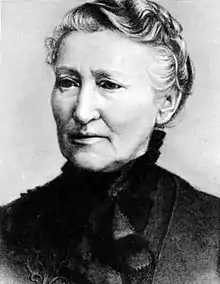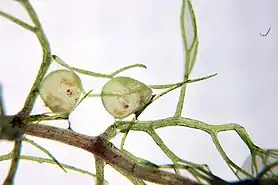Mary Treat
Mary Lua Adelia Davis Treat (7 de septiembre de 1830, Trumansburg, Nueva York – 11 de abril de 1923, Pembroke, Nueva York)[1] fue una naturalista y corresponsal con Charles Darwin. Las contribuciones de Treat, tanto a la botánica como entomología fueron extensas: cuatro especies de plantas y de animales llevan su epónimo, incluida una amaryllis, Zephyranthes treatae (hoy llamado Zephyranthes atamasca var. treatae), y una especie de hormiga: Aphaenogaster treatae.
| Mary Treat | ||
|---|---|---|
 | ||
| Información personal | ||
| Nombre de nacimiento | Mary Lua Adelia Davis | |
| Nacimiento |
7 de septiembre de 1830 Trumansburg (Estados Unidos) | |
| Fallecimiento |
11 de abril de 1923 (92 años) Pembroke (Estados Unidos) | |
| Sepultura | Nueva Jersey | |
| Nacionalidad | Estadounidense | |
| Información profesional | ||
| Ocupación | Botánica, zoóloga, entomóloga, recolector de plantas y escritora | |
| Abreviatura en botánica | Treat | |
| Abreviatura en zoología | Treat | |
Biografía
Nacida Mary Davis de una familia de clase media,, en Trumansburg, Nueva York, creció principalmente en Ohio, donde asistió a escuelas públicas y privadas de niñas. Davis se casó, en 1863, con el Dr. Joseph Burrell Treat, un abolicionista y profesor; vivieron en Iowa y en 1868 se mudaron a Vineland, Nueva Jersey.[2]
Carrera e investigaciones

Después de mudarse a Nueva Jersey, Treat comenzó estudios científicos; y, colaboró con su esposo en artículos e investigaciones sobre entomología.[2] El primer artículo científico de Treat fue publicado en "The American Entomologist" cuando tenía 39 años. Y, durante 28 años escribió 76 artículos científicos y de divulgación popular, así como cinco libros. Su investigación se expandió rápidamente desde entomología a la ornitología y botánica, detallando la vida de aves y de plantas en la región sur de Nueva Jersey..[2] En 1874, siguiendo a la separación con su esposo, Treat se sustentó a sí misma mediante la publicación de artículos de divulgación científica popular en publicaciones periódicas como Harpers and Queen. A partir de 1870, publicó artículos populares naturalistas en Garden and Forest, Hearth and Home, Harper's, y en Lippincott's.[2][3]
Su texto, Injurious Insects of the Farm and Field, originalmente publicado en 1882, fue reimpreso cinco veces. Recolectó plantas e insectos para otros investigadores, uno de los cuales fue el eminente botánico de Harvard Asa Gray. Fue a través de Gray que le presentaron a Charles Darwin. Treat escribió notas para participar en discursos botánicos y entomológicos, no solo con Darwin y Gray, sino también a Auguste Forel y a Gustav Mayr. Viajó a Florida varias veces entre 1876 y 1878 para investigar más plantas insectívoras. En uno de esos viajes, descubrió el lirio Zephyranthes treatae (nombrado en su honor por Sereno Watson) y descubrió que otro lirio no estaba extinto.[2]
Colaboración con Charles Darwin
The first recorded correspondence between Treat and Darwin originates from 20 December 1871[4] in which Treat describes the fly-catching activities of Drosera, commonly known as sundew plants. Treat and Darwin’s recorded correspondence extends over five years around the period of time when Darwin was researching, and then publishing, on carnivorous plants. They predominantly discuss these plants in their correspondence (although not the only theme, they also discussed controlling sex in butterflies), and Treat openly critiqued Darwin’s hypotheses. One notable exchange concerned the bladderwort plant, Utricularia clandestina.

Darwin’s teacher and mentor at Cambridge, John Stevens Henslow, had a clear understanding of the morphology of Utricularia (bladderwort) plants, but was not able to understand working mechanics of their traps.[5] Darwin incorrectly concluded that animals entered the traps by forcing their heads through the slit-like orifice with their heads serving as a wedge. In a letter to Treat he informed her that this subject drove him ‘half-mad’.[6] Treat became deeply absorbed in this problem, researching intensively.[7] Through long hours of observing the trapping sequence under her microscope she realised that the hairs around the entrance to the trap were sensitive and part of the process by which Utricularia traps opened, contributing new knowledge on the range of microscopic animal prey caught in these traps and the digestive processes they were subjected to.[8] Treat described it as ‘these little bladders... in truth like so many stomachs, digesting and assimilating animal food’.[7] Darwin was so impressed with Treat’s work on carnivorous plants that he referenced her, both within the main text and in footnotes, throughout his publication Insectivorous Plants (1875).[9]
By making such public affirmations of Treat’s scientific work, Darwin legitimized her role as a scientist, though this is not completely uncontested among .[10] Gianquitto’s opinion is, however, not reflected by all writers discussing Treat’s scientific identity’.[11][10] With the advent of the Internet, Treat's correspondence with Darwin has been analyzed in more detail.[12]
Legado
The best archive of Treat's life is available at the Vineland Historical and Antiquarian Society.[13] The Harvard University herbarium has a selection of Treat's specimens sent to Asa Gray and examples of their original correspondence.[cita requerida] The Darwin Correspondence Project has summaries of her correspondence with Darwin, but as yet no full coverage of the contents of their letters to each other.[6] The original letters are, in the main, available to view at Cambridge University Library. There has not been a definitive biography of Treat written.
Mary Treat is one of the main characters in the historical novel Unsheltered, by Barbara Kingsolver (published on 10/16/2018, by Harper)
Obra
Treat's works mostly detailed her observations of insects and birds in a style accessible for young children and less-educated women.[2]
- Chapters on Ants (1879)
- Injurious Insects of the Farm and Garden (1882)
- Home Studies in Nature (1885)
- Through a Microscope (1886)
- My Garden Pets (1887)
- Asa Gray: His Life and Work (1890)
Véase también
Notas
- Lorrain Abbiate Carruso & Terry Kohn, Mary Lua Adelia Davis Treat 1830-1923, p. 199-201 of Past and promise: Lives of New Jersey women, First Cyracuse University Press, 1997.
- Creese, Mary R. S. (1 de enero de 2000). Ladies in the Laboratory? American and British Women in Science, 1800-1900: A Survey of Their Contributions to Research (en inglés). Scarecrow Press. ISBN 9780585276847.
- «Mary Treat | Harper's Magazine». Consultado el 21 de abril de 2016.
- «Darwin Correspondence Project». Darwin Correspondence Project.
- Walters, M. (2001) Darwin’s Mentor: John Stevens Henslow 1796-1861 Cambridge and New York: Cambridge University Press
- «Mary Treat».
- Treat, M. (1875) ‘Plants that eat animals’ ''Gardener’s Chronicle'', March, 6th pp. 303–304
- Sanders, Dawn (2009). «Behind the Curtain. Treat and Austin’s Contributions to Darwin’s Work on Insectivorous Plants and Subsequent Botanical Studies». Jahrbuch für Europäische Wissenschaftskultur 5: 215-229. Consultado el 8 de septiembre de 2018.
- Darwin, C. (1875) Insectivorous Plants London: John Murray
- Gianquitto, T. (2003) Nobel Designs of Nature and Nation: God, science and sentiment in women’s representations of American landscape unpublished doctoral thesis Columbia University USA
- Norwood, V (1993). American Women and Nature: Made from this Earth. Chapel Hill and London: North Carolina University Press
- Canning, K. (2006) Gender History in Practice: Historical Perspectives on Bodies, Class and Citizenship. Ithaca and London: Cornell University Press
- «Archived copy». Archivado desde el original el 7 de enero de 2009. Consultado el 18 de enero de 2009.
Referencias
- Canning, K. (2006) Gender History in Practice: Historical Perspectives on Bodies, Class and Citizenship. Ithaca and London: Cornell University Press
- Darwin, C. (1875) Insectivorous Plants London: John Murray
- Gianquitto, T. (2003) Nobel Designs of Nature and Nation: God, science and sentiment in women’s representations of American landscape unpublished doctoral thesis Columbia University USA
- Gianquitto, T. (2007) Good Observers of Nature: American Women and the Scientific Study of the Natural World Athens and London: The University of Georgia Press
- Norwood, V (1993). American Women and Nature: Made from this Earth. Chapel Hill and London: North Carolina University Press
- Rossiter, M.W. (1982) Women Scientists in America: Struggles and Strategies to 1940. Baltimore: Johns Hopkins University Press
- Treat, M. (1873) ‘Controlling Sex in Butterflies’. The American Naturalist, 7, 3 pp. 129–132
- Treat, M. (1875) ‘Plants that eat animals’ Gardener’s Chronicle, 6 de marzo p. 303–304
- Treat, M. (1882) Injurious Insects of the Farm and Field. New York: Orange Judd Co.
- Treat, M. (1885) Home studies in Nature. New York: American Book Co.
- Walters, M. (2001) Darwin’s Mentor: John Stevens Henslow 1796-1861 Cambridge and New York: Cambridge University Press
Enlaces externos
Abreviatura (zoología)
La abreviatura Treat se emplea para indicar a Mary Treat como autoridad en la descripción y taxonomía en zoología.
- La abreviatura «Treat» se emplea para indicar a Mary Treat como autoridad en la descripción y clasificación científica de los vegetales.[1]